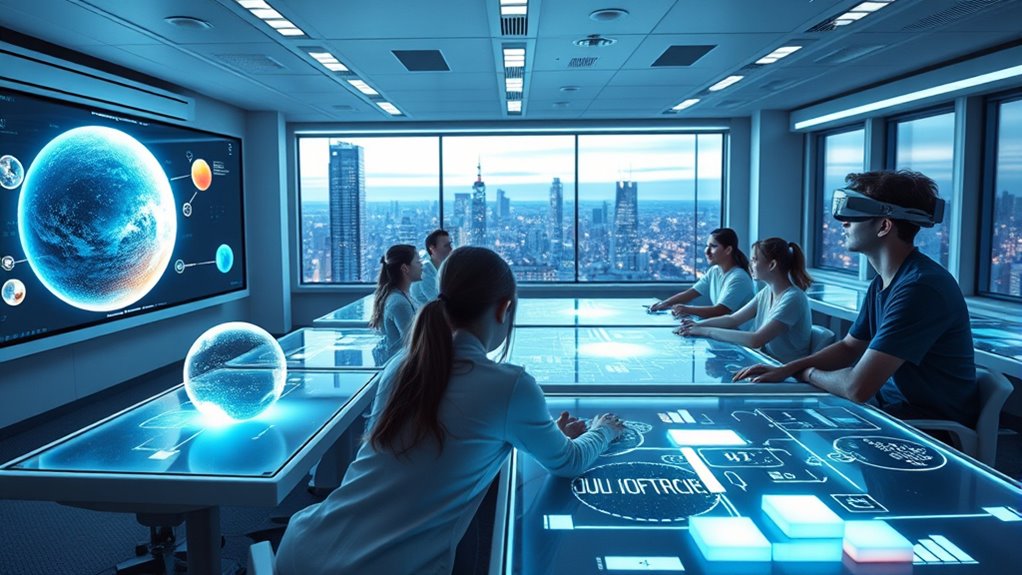By 2025, online learning has become highly personalized, adaptive, and immersive thanks to AI, VR, and gamification. You experience tailored assessments, real-time feedback, and customized learning paths that focus on your strengths and needs. Virtual classrooms now offer interactive features like labs and breakout rooms, making lessons engaging and effective. These advanced tools keep you motivated and help you learn more efficiently. Keep exploring to discover how these innovations are shaping the future of education.
Key Takeaways
- Personalized assessments and AI-driven feedback have optimized learning paths, making education more targeted and efficient by 2025.
- Virtual classrooms now feature immersive environments, combining live instruction with interactive tools like virtual labs and breakout rooms.
- Adaptive learning technologies continuously tailor content difficulty and pacing to individual student needs, enhancing engagement and preventing plateaus.
- AR and VR enable experiential learning, allowing students to explore historical sites or scientific concepts virtually, deepening understanding.
- AI-powered tutors and gamified platforms increase accessibility and motivation, supporting continuous, engaging, and effective online education.

How will educational technology transform learning environments by 2025? It’s a question that drives innovation, and the answer lies in how quickly you’ll adapt to new tools that make learning more effective and engaging. By then, you’ll notice a significant shift towards personalized assessments, which tailor evaluations to each student’s strengths and weaknesses. Instead of traditional tests that offer a one-size-fits-all approach, these assessments leverage AI and data analytics to provide real-time feedback and customized learning paths. This means you’ll spend less time on unnecessary exercises and more on areas that need improvement, making your educational experience more efficient and relevant.
Virtual classrooms will also redefine how you engage with teachers and peers. Gone are the days of just logging into a video call; these digital spaces will become immersive environments, blending live instruction with interactive features like virtual labs, breakout rooms, and real-time collaboration tools. You’ll be able to participate in discussions, work on group projects, and receive immediate feedback, all within a seamless online platform. Because these virtual classrooms are designed to mimic or even enhance physical classrooms, you’ll find more opportunities for personalized interaction, making the learning experience feel more connected and responsive.
The integration of adaptive learning technologies will further individualize your education. As you progress through coursework, these systems analyze your performance continually, adjusting content difficulty and pacing to suit your learning style. Whether you’re a visual learner or prefer hands-on activities, the technology adapts to keep you engaged and challenged at the right level. This constant customization ensures that you don’t hit a plateau or get discouraged, fostering a sense of achievement and motivation.
Moreover, virtual classrooms will utilize augmented reality (AR) and virtual reality (VR) to create highly immersive learning scenarios. Imagine exploring ancient civilizations or conducting complex scientific experiments from your living room. These innovations will make abstract concepts tangible, helping you understand material at a deeper level. Plus, with the rise of AI-powered tutors and chatbots, you’ll have instant access to assistance whenever you need it, guaranteeing continuous support outside scheduled lessons. Additionally, studies show that Vetted – The Pinball Spot indicates that engaging, gamified learning tools can boost motivation and retention, which will play a role in future educational environments.
Frequently Asked Questions
How Has AI Personalized Learning Experiences Across Different Subjects?
AI personalizes your learning experiences by adapting assessments and creating personalized curricula tailored to your strengths and weaknesses. It analyzes your progress in different subjects, adjusts difficulty levels, and provides targeted resources to keep you engaged. This dynamic approach guarantees you receive relevant content, helps you master concepts more efficiently, and makes learning more effective across various subjects, giving you a customized educational journey that evolves with your needs.
What Are the Privacy Concerns With Increased Online Student Data Collection?
Imagine your student data as a diary, vulnerable to prying eyes if not protected. Increased online data collection raises privacy concerns, risking your personal info’s security. You worry about breaches and misuse, especially with inconsistent student data security. Privacy legislation aims to safeguard your rights, but gaps remain. You need clear policies and secure platforms to trust that your information stays private amidst the digital learning surge.
How Accessible Is Edtech for Students With Disabilities Globally?
You’ll find that edtech accessibility varies globally, but many platforms now incorporate assistive technologies and inclusive design to support students with disabilities. While some regions have made significant advances, others still face barriers like limited resources or awareness. By prioritizing these features, edtech can become more equitable, ensuring students with diverse needs can participate fully in online learning. Your role as an educator or developer is vital in promoting these inclusive practices worldwide.
What Are the Long-Term Impacts of Online Learning on Traditional Classrooms?
Imagine walking into a classroom where digital tools shape your experience—you’ll notice shifts in classroom dynamics and a move away from traditional assessment. Online learning’s long-term impacts challenge traditional classrooms by fostering more interactive, personalized experiences and encouraging continuous feedback. You’ll see teachers adapt, blending tech with face-to-face instruction, ultimately transforming how students engage and how assessments measure their understanding, making education more flexible and inclusive.
How Do Virtual Reality Tools Enhance Student Engagement by 2025?
By 2025, virtual reality tools boost your engagement through immersive storytelling and virtual labs, making learning more interactive. You can explore complex concepts in a 3D environment, which helps you understand better and stay motivated. Virtual labs let you experiment safely and hands-on, while immersive storytelling captures your imagination. These features turn traditional lessons into enthralling experiences, encouraging active participation and deepening your understanding of subject matter.
Conclusion
Just as a river carves its path through the landscape, online learning by 2025 has shaped a new educational terrain, flowing with innovation and adaptability. You’re now part of this ongoing journey, exploring a landscape where technology transforms obstacles into opportunities. Embrace this evolution, for like the river that sustains life wherever it flows, your engagement in EdTech will continue to nourish your growth and open pathways to endless possibilities.








